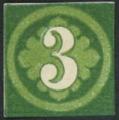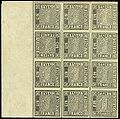Black ones
| Black ones | |
|---|---|

|
|
| output | |
| country | Kingdom of Bavaria |
| Face value | 1 cruiser |
| First day | November 1, 1849 |
| Date of Expiry | August 31, 1864 |
| layout | |
| Motif | Digit drawing |
| colour | black |
| draft | Johann Peter Haseney |
| Sting | Max Josef Seitz |
| Print type | Letterpress |
| perforation | Cut |
| particularities | Handmade paper |
| Edition | |
| Edition | 832,500 |
The Black One is the first stamp from the Kingdom of Bavaria and the first stamp issued in Germany .
history
After postage stamps had already been introduced in England in 1840, the first proposal for postage stamps in Bavaria came from the Munich Upper Post Office in February 1845. Even before the decision was made on the number motif, a leaf essay was also under discussion. There are various two-tone prints of this. In the middle of these essays there is a large number 3 in front of a kind of leaf.
The first German postage stamp was issued in the Kingdom of Bavaria on November 1, 1849 . It is commonly referred to as the "black ones" due to the large number and the color of the brand. The nominal value is a kreuzer , the postage at that time for a local letter and for sending printed matter such as price lists or advertising brochures. The motif was designed by Johann Peter Haseney . The stamp was printed on handmade paper and is cut .

The black ones was the smallest of a whole series of very similar brands. The blue 3-Kreuzer and brown 6-Kreuzer stamps appeared at the same time. At the time of publication, on the All Saints holiday , only large post offices were open and so far only a few stamps have appeared that were already in use on November 1st (recognizable by the stamp or letter date).
The design of the brand in black did not prove itself, as it was canceled with black stamp ink. The black ones were therefore soon replaced by a new edition, the pink 1-Kreuzer, the design of which was adapted to the 3 and 6-Kreuzer stamps. In October 1851 the stamp was withdrawn from counter sales, but remained valid for postage until August 31, 1864.
In the following years other values of the series appeared, a 9-Kreuzer in green, 12-Kreuzer in red and 18-Kreuzer in orange. In the course of an agreement within the framework of the German-Austrian Post Association, which agreed on the same printing colors for the same value levels, the colors of the stamp series were changed again. From then on, the stamp for a cruiser was printed in yellow.
Description and characteristics
The black ones were created on two different plates, the first plate causing a fuzzy, rough print. The second plate from 1850 produced a clearer print, which can be recognized in particular by the “undamaged” left foot of the large number '1'. With the first printing plate, the printing took place on a double sheet of 180 pieces and with the second plate only on a single sheet of 90 pieces, because this improved the print quality. The edition was 832,500 pieces (plate 1: 472,500, plate 2: 360,000). Despite this rather high circulation, the Black One is very popular with collectors and reaches collector values of 1000 to 3000 euros.
Both editions have an unmistakable security feature, namely the names of the designer and the engraver hidden in the seemingly chaotically patterned background of the large number. With the appropriate enlargement and respective rotation of the stamp to the left of the 1 on its spread, the initials PH (Peter Haseney), as well as at the bottom right of the foot next to the 1, you can even see the name of the WEISS (university book printing company Johann Georg Weiß) in Recognize cursive.
The brand itself is very susceptible to forgery, an examination is always recommended, as clever forgers knew exactly how to imitate the initials and the lettering. The best known are the copies made by the forger Sperati (1884–1957). These pieces are sought after by specialists and fetch considerable prices.
Rare collectibles
A special rarity is the so-called "Eichstätt letter" with the only known block of six of black ones. It was discovered in 1958 in old documents from the city of Eichstätt . Since March 1999 it can be seen in the treasury of the Berlin Museum for Communication .
On May 7, 2009, Deutsche Post issued a special stamp with a surcharge on the day of the postage stamp , which depicts the Eichstätt letter. This mark has a security feature: two horizontal marks form an oak leaf in the perforation. In addition, the sheets of ten are numbered consecutively.
There is also a letter with two three-stripes from Neustadt an der Aisch , which was auctioned on November 22, 2008 by a Bavarian stamp auction house for the price of € 55,000 (+ premium). There are also two letters, each with 6 individual black ones glued next to each other, from the same correspondence from Lauf an der Pegnitz . One of them achieved 185,000 marks around 1988, the other was sold for 100,000 marks in the 1960s.
A block with twelve related stamps was auctioned off in March 2009 by the Heinrich Köhler auction house with a bid of 320,000 euros. The special feature of these stamps is an inverted version within the print. This piece was already in the collections of Dale-Lichtenstein until 1992 and Philipp von Ferrary until 1923.
One of the few surviving sheets (with a total of 90 stamps) was auctioned on March 27, 2010 for 300,000 euros in Wiesbaden. A double sheet with 180 copies was sold for $ 687,000 at auction house Götz in 1992 .
Eichstätt letter on a German postage stamp from 2009
Special stamp for the 100th anniversary on a German postage stamp from 1949
Issue for Stamp Day in the GDR from 1949
Trivia
In the 906th episode of the program Who Wants to Be a Millionaire , Ralf Schnoor won one million euros with the answer "Black ones".
The stamp was the inspiration for the name of the black ones crime scene .
literature
-
Collector Express
- Issue No. 21/1974, Wolfram Grallert: 125 years "Bavaria No. 1" , p. 488
- Issue No. 7/1980, Heinrich Jung: The black ones of JP Haseney , p. 223
- Deutsche Briefmarken-Review issue No. 9/1999, p. 49 f
- Kurt Karl Doberer : Bavaria Philately. History of the Bavarian postage stamps. Phil Creativ Verlag, Schwalmtal, 1990, 161 pages, ISBN 3-928277-00-6
- Helbig , Vogel: Michel catalog black ones. For the 150th anniversary , publisher: Schwaneberger 1999, 104 pages, ISBN 387858525X
- 160 years of the “Black One”. (Continuation article ) In: Deutsche Briefmarken-Zeitung , from issue No. 22/2009 to No. 25/2009
- Philatelist Club Bavaria eV: Schwarzer Einser & Co. In: Michel-Rundschau No. 2/2008, pp. 14, 16
- Joseph de Hesselle: Der Schwarze Einser , Munich 1949, reprint from 1989, 92 pages
- The Black One - the first German postage stamp , booklet for the exhibition of the same name in the Museum for Post and Communication Nuremberg, Museum Foundation Post and Telecommunication 1999, 34 pages
- Peter Sem: Bavaria Special Catalog Volume I, Handbook of Cruiser Editions , 8th edition, self-published, Gundelsheim 2000, 480 pp.
- Archive for Postal History in Bavaria , 1930 No. 2, p. 110 ff
Further references can be found in the work of Christoph Otto Müller : Bayern-Bibliographie , from 1961 on pages 10-11.
Web links
- The "Eichstätt letter" - Bavaria MiNr. 1 on the site of the Museum Foundation Post and Telecommunications
- Background information on this at the 355th Koehler auction (PDF; 5.0 MB)
Individual references, comments
- ^ Kurt Karl Doberer: Bavaria Philately. History of the Bavarian postage stamps. Phil Creativ Verlag, Schwalmtal, 1990, ISBN 3-928277-00-6 , p. 20
- ^ Kurt Karl Doberer: Bavaria Philately. History of the Bavarian postage stamps. Phil Creativ Verlag, Schwalmtal, 1990, ISBN 3-928277-00-6 , p. 22
- ^ Peter Zollner: For the 160th birthday of the first German postage stamps. In: philately issue no. 389 from November 2009, pp. 46–48
- ↑ Cf. Michael Burzan: Speratis Meisterstücke: Works from Old Germany (II / 2) - The Black One of Bavaria. (from a series of articles) In: philately , issue no.415 from January 2012
- ^ A b mint never hinged, Das Philatelie-Journal der Deutsche Post AG , January / February 2008 edition, p. 27
- ^ Andreas Hahn (Ed.): Treasures of Philately , Catalog of the Museum Foundation Post and Telecommunication Volume 14, ISBN 3-980 8448-0-3 , p. 26
- ↑ a b c Wolfgang Maassen: Three times six or two three correct numbers: also a dream quota. In: philatelie - the collector's magazine of the Association of German Philatelists , issue no.375 from September 2008, pp. 48 to 50
- ↑ a b c Auktionshaus Heinrich Köhler, 335/336 auction, lot number 2 ( page no longer available , search in web archives ) Info: The link was automatically marked as defective. Please check the link according to the instructions and then remove this notice. , accessed June 22, 2012
- ↑ philately issue no.420, June 2012 (advertisement from the Heinrich Köhler auction house on the back of the booklet)
- ↑ "The dream of every stamp collector" bought first German stamp for 250,000 euros on t-online on March 29, 2010
- ↑ Das Archiv issue No. 1/2004, p. 44 f
- ↑ Treichel, Inge: Die Welt- Jauch's millionaire “ I lied to everyone ”, accessed on February 22, 2016









